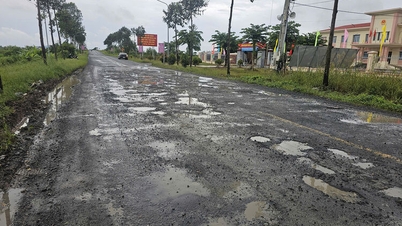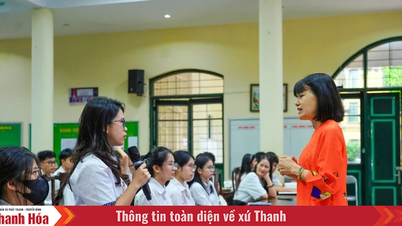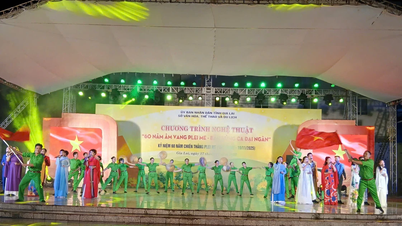
Civil servants of the Public Administration Service Center of Hac Thanh ward handle administrative procedures for citizens.
As the central urban area of the province, the Public Service Center of Hac Thanh Ward uses the entire spacious and spacious "one-stop" infrastructure system of Thanh Hoa City (old). However, this is the ward with the largest population in the province (more than 197,000 people) and has many operating businesses, so the biggest difficulty in Hac Thanh is the large number of administrative procedure files received and processed. On average, each month, the Public Service Center of Hac Thanh Ward receives and processes 4,500 - 5,000 administrative procedure files. The number of files is large, but the staff is only 12 people, so they often have to work overtime and work on holidays. People have to wait a long time, leading to frustration, which is inevitable.
To reduce pressure on officials and civil servants and improve the quality of service to the people, recently, the People's Committee of Hac Thanh ward has sent a document to the Provincial People's Committee requesting to arrange additional points for receiving administrative records. The Provincial People's Committee has agreed in writing with the proposal of Hac Thanh ward to arrange additional locations for receiving records and returning results of the ward's Public Service Center at the Provincial Public Service Center, expected to be implemented by the end of November 2025. This will be an important solution for Hac Thanh to better achieve the goal of serving organizations and citizens.
Unlike Hac Thanh, after the merger, the Nguyet Vien Ward Public Service Center reused the facilities from the “one-stop shop” department of the old Hoang Quang Ward. Previously, this “one-stop shop” department only served organizations and citizens of Hoang Quang Ward, but after the merger, it had to serve organizations and citizens of 4 wards, so it was quite cramped. Ms. Do Thi Trang, Deputy Director of the Public Service Center of Nguyet Vien Ward, said: “In addition to the difficulties in facilities, many people, especially the elderly, do not use smartphones, do not use computers, have not installed the VNeID application level 2 or have installed it but have forgotten the password, so the center's civil servants have to spend a lot of time guiding them when using online public services. Many people, when submitting their applications, are created accounts by civil servants and guided through the steps of submitting online applications, but they are reluctant to accept it and want ward officials and civil servants to do it for them. In addition, sending OTP codes to confirm the implementation of administrative procedures is often slow; many times the network system is congested, civil servants have to re-enter the application from the beginning, which takes a lot of time.”
At the recent training conference on the use of the National Public Service Portal and the Provincial Administrative Procedures Information System for more than 1,000 cadres, civil servants, and public employees of the People's Committees of communes and the Public Service Centers of 97 communes and wards, Director of the Provincial Public Service Center Nguyen Tuan Hoa pointed out the limitations and difficulties in implementation: Many communes and wards have overdue settlement records due to the delay of cadres and civil servants in advising on the settlement of records or in updating the settlement results on the Provincial Administrative Procedures Information System. In some communes and wards, civil servants and public employees have not yet exploited and used information on citizens' residence on the National Population Database connected to the Provincial Administrative Procedures Information System to settle administrative procedures, but still require people to present a certificate of residence information, notify personal identification numbers; the situation of requesting additional documents outside of regulations still occurs.
For files that require additional information or return to people and businesses because they do not meet the requirements for processing, many localities have not handled and responded in accordance with regulations. Specifically, such as the issuance of documents returning files after the deadline; documents returning files with the reason that citizens requested to withdraw but the system did not have the citizen's withdrawal request; there was no response document from the unit agreeing to let citizens withdraw files; documents returning files have not been stamped according to regulations... Regarding the digitization of files and results of handling administrative procedures, many localities still do not comply with regulations. In particular, through monitoring on the Thanh Hoa Feedback System, many wards and communes responded to citizens inappropriately, not specifically, not clearly.
To help the Commune-level Public Service Center operate stably and smoothly, in recent times, the Provincial Public Service Center has coordinated with relevant units to organize many professional training sessions for officials and civil servants on receiving and processing records on the Provincial Administrative Procedure Information System; providing instructions on submitting records online and making online payments on the National Public Service Portal; and fully developing electronic eForms to facilitate people to submit records online quickly and easily. The Provincial Public Service Center has also reviewed the list of provincial and commune-level administrative procedures, ensuring accuracy and standardization of administrative procedures; and at the same time, publicized the list of officials and civil servants of the center to be ready to guide localities in handling arising situations promptly.
With the active support of the Provincial Public Administration Center, and the proactive learning attitude of the staff and civil servants of the Public Administration Center of wards and communes, difficulties and obstacles will continue to be resolved, so that the 2-level local government model not only operates smoothly, but also builds trust with the people.
Article and photos: To Phuong
Source: https://baothanhhoa.vn/go-kho-de-van-hanh-tron-tru-269090.htm






![[Photo] General Secretary To Lam and National Assembly Chairman Tran Thanh Man attend the 80th Anniversary of the Traditional Day of the Vietnamese Inspection Sector](https://vphoto.vietnam.vn/thumb/1200x675/vietnam/resource/IMAGE/2025/11/17/1763356362984_a2-bnd-7940-3561-jpg.webp)



































































































Comment (0)